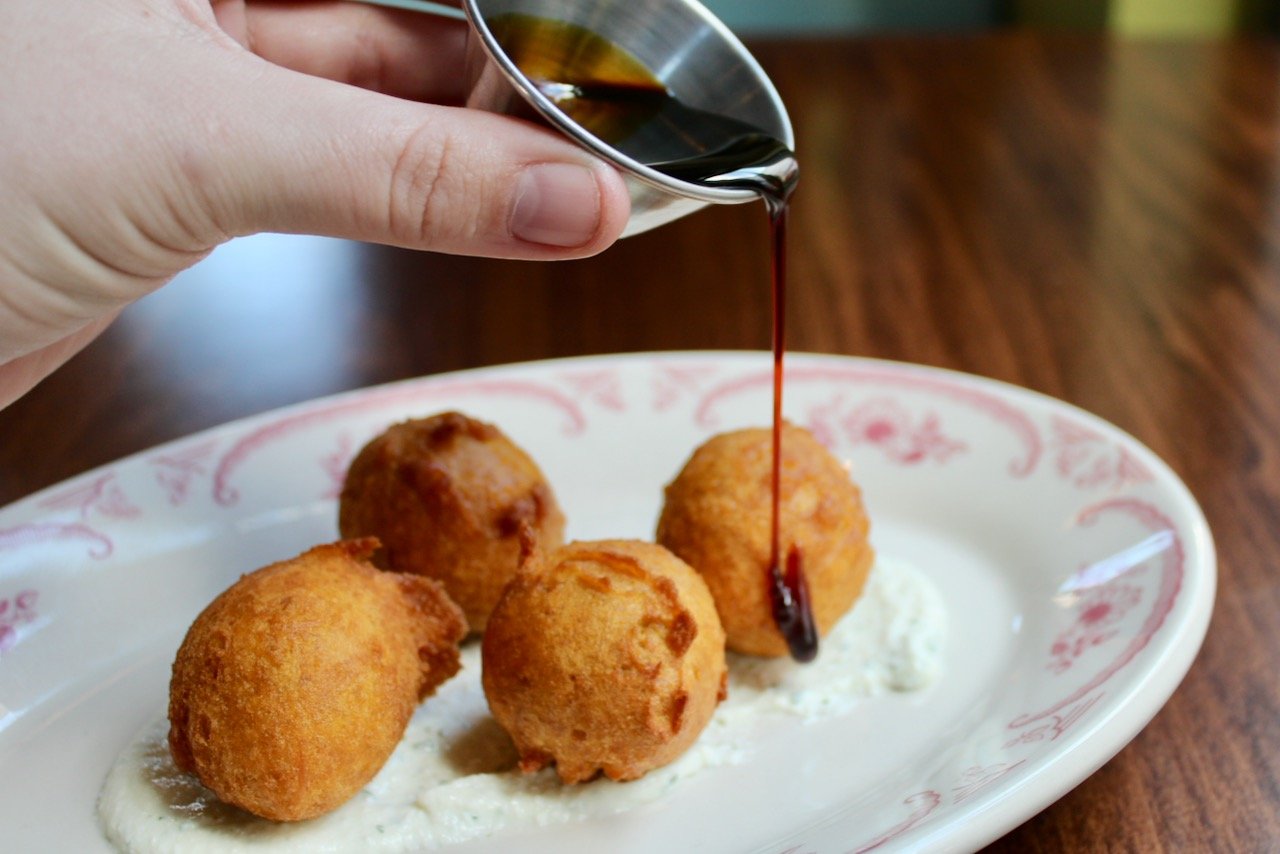Sweet as Sorghum
by Donna Hecker
I assure you there is nothing more beautiful than sorghum syrup being poured into a glass vessel, or more heavenly than hot, new sorghum on a piece of pound cake, itself sweetened with sorghum. It is sexy, it is overkill, it is soul-making, it was so good that I bought more and ate them before G-d gave me two more days of life.
-Michael W. Twitty, author of The Cooking Gene: A Journey Through African American Culinary History in the Old South.
Sorghum drizzled over a cake. Photo by Talitha Schroeder
Twitty’s praise song to sorghum was inspired by a visit to a Mennonite farm in middle Tennessee, where he hoped to visualize memories of his enslaved ancestors cooking sorghum. He was disappointed that seeing the process did not conjure up vivid scenes of the men in his family feeding the mill, chasing the mule, and boiling the cane; but he finally understood why his grandfather’s inheritance included twenty gallons of sorghum molasses.
Sorghum came to Kentucky, as to all of North America, from the African continent. Known as “Guinea corn”, according to Twitty, its cultivation often centered around settlements of enslaved people and at least one variety can be traced to a cultivar known as imphee, with roots in the Zulu empire.
Often mistaken for corn, sorghum is a type of grass relatively easy to grow and process for a variety of uses. It’s been planted in North America since colonial times but Randal Rock of Country Rock Sorghum likes to say that if anybody tells you Abe Lincoln cut sorghum as a lad, they’re lying. Sorghum didn’t become widely popular until the 1850s when it emerged as a cheaper alternative to sugarcane, an attribute even more valuable during the Civil War and the ensuing embargo of goods on the Mississippi River.
Sorghum grown at Country Rock Sorghum. Photo #1, umbrella sorghum. Photos #2&3 dale sorghum. Photos courtesy of Country Rock Sorghum
Sorghum has always been a versatile crop. Its towering stalks provided straw for brooms, silage for livestock, and sweet syrup for eating and cooking. Brooms once crafted by the Shakers at Kentucky’s Pleasant Hill are still made from a sorghum variety called broomcorn and sold in the village gift shop. Shakers are no longer with us but until the last member’s death in 2017, they steadfastly adhered to Mother Ann Lee’s call to put their hands to work and their hearts to God.
Although today’s large sorghum growers employ factory-floor efficiency in their production practices, the molasses we like to buy and use comes from smaller producers like Randal Rock who follow Mother Ann’s dictate of putting hands to work.
We bake Randal’s Country Rock sorghum into our Midway Bakery spice cookies, whisk it into sorghum vinaigrette, and infuse it with warm spices to drizzle over hot sweet potato beignets.
Come September, Randal cuts his sorghum with a well-worn machete before beheading the cane and feeding it into a mill for juice extraction. The juice cools in a converted milk cooler (a process called defecation as the solids settle), then is preheated en route to an evaporator pan. It’s hands-on all the way from setting the seeds to weeding to harvesting to the final cooking and bottling.
Sorghum cooking is a magical thing to see and hear. The roar of the propane tanks plays bass under the hiss and roiling of the boiling juice which, like salmon scaling ladders, has to make its way forward and upward through channeled steel baffles. As juice becomes syrup and reaches the other end, it’s said to be “smoking its pipe” in eastern Kentucky parlance or, in Randal’s words, making limpid “sheep’s eyes” bubbles.
While the syrup cooks, someone is constantly stirring and skimming “the frogs” as some call the impurities that float to the top. There was a time when even the skimmings were a treat, and our old friend Norma Jean Campbell, now in her nineties, remembers being handed a cupful to savor while adults tended to the cooking. Young Norma Jean was not one to share and hid her cup in a flower bed with the help of a chivalrous, long-armed cousin.
Sorghum making. Photo by Donna Hecker
Making sorghum molasses used to be a community affair. Family and neighbors came together on the farm to share resources and responsibilities. Twitty writes that sorghum masters were often old black men and that “it was one of the few environments where a soft sort of integration occurred with Southern whites and blacks interacting with each other over a foodstuff.”
Today the sorghum maker is more likely to demonstrate his craft at festivals and farmers markets, where he can sell his sorghum molasses and other value-added products. Randal Rock sets up at the Fall Festival in Midway, Ky. every September, while Jimmy Elliott of Poorhouse Sorghum works the Springfield Sorghum Festival in early October. Jimmy’s father Woodsy started the Springfield festival in 1977 and Jimmy keeps a snapshot in an album at his booth of the two of them posing proudly on the steps of the Washington County courthouse.
As in Michael Twitty’s family, it’s still mostly men who make sorghum and pass the skill down to sons, sometimes skipping a generation like Randal’s did. The Elliott family passed the skill from Woodsy to Jimmy to Jimmy’s granddaughter Kaitlyn, who began working alongside him in Gravel Switch when she was just thirteen. Kaitlyn loved farming with her grandaddy so much she majored in Ag Science at the University of Kentucky and now advises FFA students at the Florida high school where she teaches.
Twitty tells of sorghum being used to make a taffy in the Sahel of West Africa, long before its introduction to North America. At Ruth Hunt Candy in Mount Sterling, Larry Kezele and his staff convert sorghum into suckers. During a recent sucker-making demonstration even the normally nonstop chocolate-coating conveyor belt sat idle while Larry called a small army to attention.
The moment the copper candy pot was emptied and its molten amber contents hit the marble slab, hands got busy — turning the hot candy over until it was cool enough to work. Next came the staccato clack of scissors clipping the pliable ropes into sucker-sized pieces. Like kids catching treats at a parade, workers scrambled for the still soft bits, deftly flattening them and affixing them to paper sticks.
In five minutes it was all over and 300 sorghum suckers lay hardening on metal sheet pans.
Sorghum sucker assembly at Ruth Hunt. Photos by Talitha Schroeder
Once the suckers were set, other hands gave them a final flourish, wrapping the candies in origami folds of waxed paper. A sharp triangle and then two twists and turns and they were ready for the candy jar. Or, as Ouita prefers, ready to be swirled in a tumbler of bourbon until the flavors fuse and the sorghum nudges the bourbon’s finish almost to infinity.
From Africa to North America, sorghum has spun a thread to our past, smoothed out rough spots, brought town to farmer and farmer to town. From field to mill and pan to jug, hands were put to work. And the result? Well, there’s a saying in faraway New Zealand that when all is right with the world and life is good, it’s “sweet as.” Surely that sums up sorghum.
Sorghum Jugs, illustrated by Brenna Flannery
© 2021, Holly Hill Inn/Ilex Summit, LLC and its affiliates, All Rights Reserved
Related Content
Sweet Potato Beignet
It's a party! Recreate our popular Honeywood appetizer at home and start your holiday off right with this perfect blend of sweet and savory flavors.











